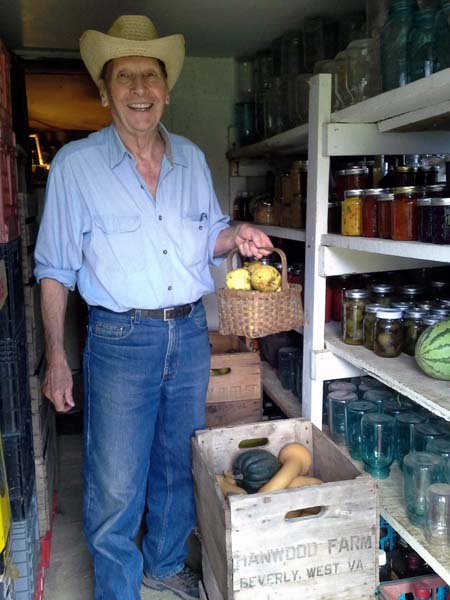Summer in a Jar
By Edwin Daryl Michael

Our author, Edwin Daryl Michael, shows off some fresh food in the root cellar of Arden and Dawn Swecker, located just south of Beverly in Randolph County. All photos courtesy of our author.
My grandmother, Essie Myres Gump, used to say, “Opening a jar of peaches in winter brightens the day as much as opening an outside door in spring.”
The bright orange color of a jar of peaches certainly resembles the bright sun, while its syrupy juices evoke sweet memories of previous summers. I vividly remember climbing the hill behind my grandparents’ house on Plum Run in Marion County and picking bushels of the yellowish-orange fruits commonly called old-fashioned peaches. Although they might have been smaller than the freestone varieties we “imported” from Romney, they tasted equally scrumptious on a cold winter day.
Tasty summer memories certainly made life more enjoyable during the dark winter days while holding promises for the future. An opened jar of peaches promised an eventual end to winter and a return of bright sunny spring days with birds singing, flowers blooming, and peach trees blossoming. Likewise, jars of peaches—and green beans, red tomatoes, and yellow sweet corn—reminded us of plentiful seasons of the past and seasons to come.
Two essential developments made these miraculous jars possible: the simple glass canning jar and the lowly root cellar. Pioneers discovered that the West Virginia hills produced a great diversity of food and that the land would sustain them, especially if they had enough children to help work from daylight to dark. The list of potential foods seemed endless: apples, peaches, pears, plums, corn, wheat, oats, buckwheat, beans, peas, peppers, tomatoes, squash, potatoes, beets, carrots, onions, cucumbers, and sorghum molasses. In addition, woods and fields yielded paw paws, persimmons, blueberries, blackberries, raspberries, strawberries, service berries, grapes, chestnuts, hickory nuts, walnuts, butternuts, mushrooms, ramps, honey, maple syrup, squirrels, rabbits, bear, deer, and turkeys. Although bottomlands produced enough hay to support sheep, cattle, and horses, only the richest landholders typically owned this prized acreage. As a result, mountain farmers often relied on pigs, which could forage in the woods or be fed with food scraps, or slop.
Food was abundant in the summer and early fall but much less so during winter. Fortunately, livestock and wild game could be slaughtered and butchered during the coldest months, and much of it was preserved through curing and smoking. Fruits and vegetables, however, presented storage problems. Barrels, bushels, and crates of fruits and vegetables were harvested, but most remained edible for only a few days or weeks.
The challenge for settlers was how to preserve and store wild and cultivated food to get through the winter on more than just meat. In the 1700s and early 1800s, settlers used various preservation techniques, such as storing food in cool root cellars. Some turned to more creative ideas. In early fall, my grandparents dug outdoor pits, lined them with dry hay or straw, and filled them with potatoes, turnips, beets, cabbage, pears, or apples. Each pit contained only one kind of fruit or vegetable. They placed a two-foot layer of soil and sod on top to protect the food from animals and freezing. Ideally, temperatures in the pits would remain in the mid-30s. Once a week, someone dug a small opening in the sides of the pits, reached in, pulled out enough vegetables and fruits for the week, and then plugged the opening.
In the late 1800s, the development of glass canning jars revolutionized food preservation. Glass jars (pints, quarts, or half-gallons) were ideal for storing most vegetables, fruits, and meats. In 1858, John Landis Mason patented a molded glass jar with a metal ring and a steel lid and rubber gasket on the underside. It drastically changed how we preserve food. Boiling and then cooling the jars and their contents seal the lids and preserve the contents for months or even years. Some of the more common canned foods in my family were peaches, green beans, peppers, sweet corn, beets, spare ribs, chicken breasts, and pickles.
The art of canning made life more enjoyable, but there was still one problem: glass jars filled with produce or meat would freeze and burst if stored in unheated buildings. A family of eight to 10 children could require up to 1,000 jars of canned foods to make it through the winter, and most farmhouses lacked this much storage. Limiting the space even more, temperatures often dropped below freezing in rooms along a home’s outside walls. I remember awaking many mornings to find my bedroom window glazed on the inside with a layer of ice. Basements were nearly nonexistent because they had to be hand-dug and were continually damp. The solution often came in the form of root cellars, which maintained near-constant, above-freezing temperatures.
You can read the rest of this article in this issue of Goldenseal, available in bookstores, libraries or direct from Goldenseal.